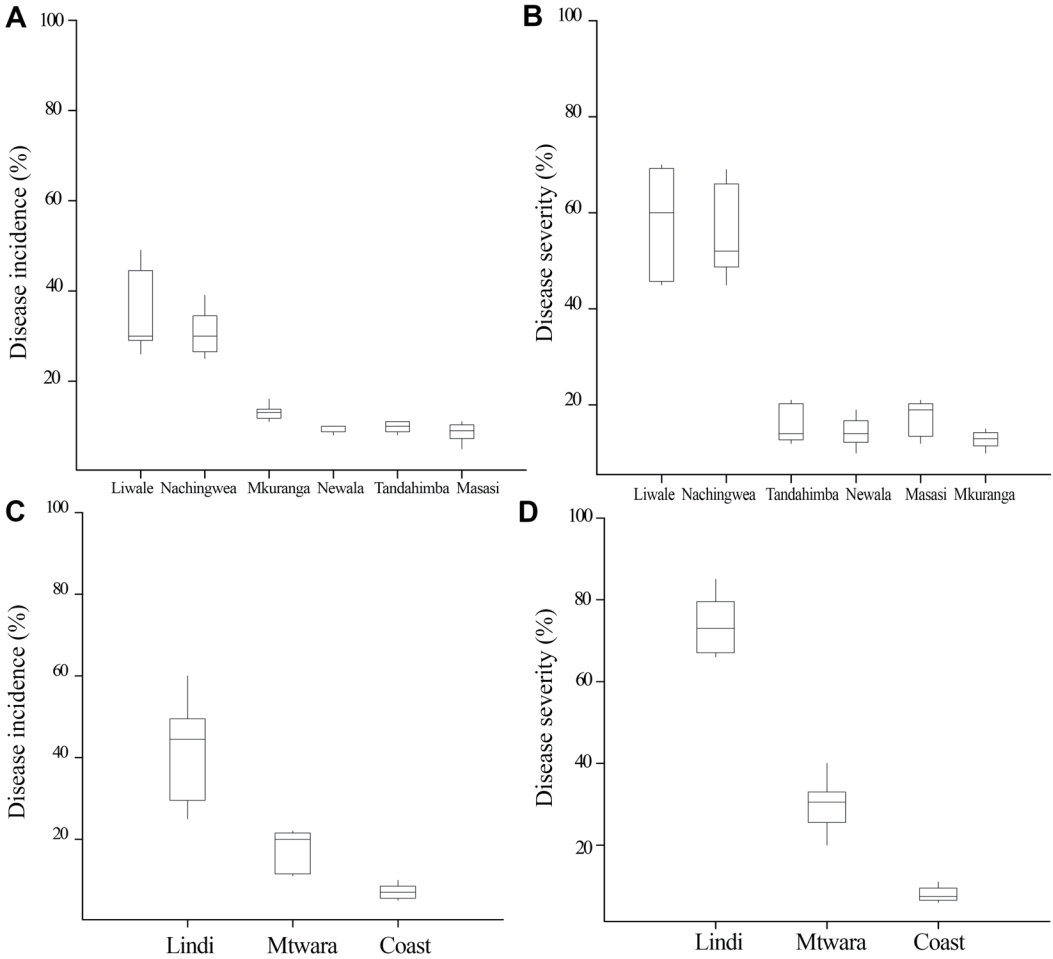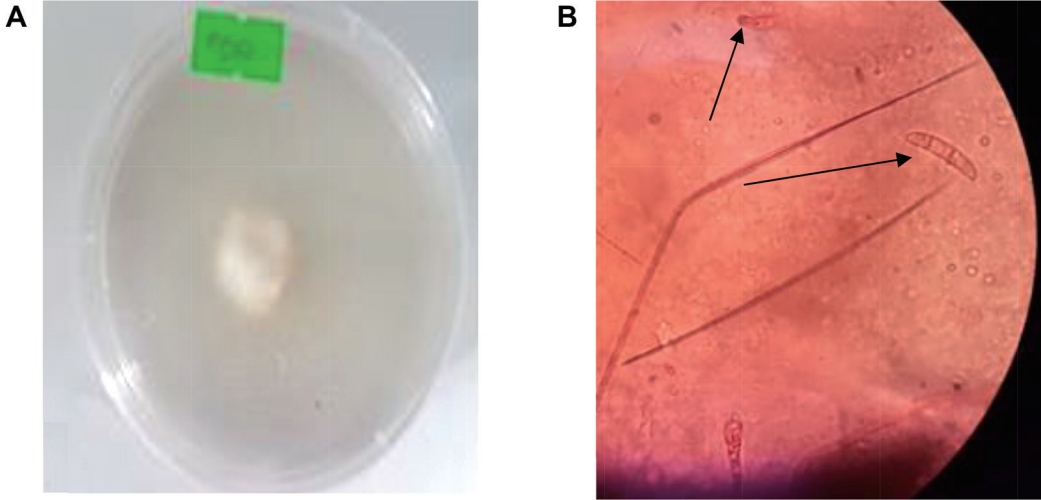Abdel-lateif, K. S. 2017. Trichoderma as biological control weapon against soil borne plant pathogens.
Afr. J. Biotechnol. 16: 2299-2306.

Alves-Santos, F. M., Benito, E. P., Eslava, A. P. and Díaz-Mínguez, J. M. 1999. Genetic diversity of
Fusarium oxysporum strains from common bean fields in Spain.
Appl. Environ. Microbiol. 65: 3335-3340.



Amata, R. L., Otipa, M. J., Waiganjo, M., Wabule, M., Thuranira, E. G. and Erbaugh, M. et al. 2009. Incidence, prevalence and severity of passion fruit fungal diseases in major production regions of Kenya. J. Appl. Biosci. 20: 1146-1152.
Attri, K., Sharma, M. and Gupta, S. K. 2018. Influence of edaphic factors on Fusarium wilt of bell pepper.
Int. J. Bio-resour. Stress Manag. 9: 606-610.

Campbell, C. L. and Neher, D. A. 2016. Estimating disease severity and incidence. In: Epidemiology and Management of Root Diseases, eds. by C. L. Campbell and D. M. Benson, pp. 117-147. Springer, Berlin, Germany.
Devika, B., Fatima, S. and Sonawane, B. N. 2017. Impact of physical factors on growth and sporulation of saprophytic pathogenic fungi. Int. J. Eng. Dev. Res. 5: 1346-1350.
Domínguez, J., Negrín, M. A. and Rodríguez, C. M. 2000. Aggregate water-stability, particle-size and soil solution properties in conducive and suppressive soils to Fusarium wilt of banana from Canary Islands (Spain).
Soil Biol. Biochem. 33: 449-455.

Dominic, M. and Makobe, M. 2016. Biological control of cashew powdery mildew using
Ampelomyces quisqualis Ces.
J. Biol. Control 30: 226-235.

Fang, X., You, M. P. and Barbetti, M. J. 2012. Reduced severity and impact of Fusarium wilt on strawberry by manipulation of soil pH, soil organic amendments and crop rotation.
Eur. J. Plant Pathol. 134: 619-629.

Fassihiani, A. 2000. Symptomless carriers of the causal agent of tomato wilt pathogen. J. Agric. Sci. Technol. 2: 27-32.
Food and Agriculture Organization of the United Nations. 1982. Micronutrients and the Nutrient Dtatus of Soils: A Global Study. FAO Soils Bulletin. Food and Agriculture Organization of the United Nations, Rome, Italy. pp. 458 pp.
Food and Agriculture Organization of the United Nations. 2015. World Reference Base for Soil Resources 2014. International Soil Classification System for Naming Soils and Creating Legends for Soil Maps. Food and Agriculture Organization of the United Nations, Rome, Italy. pp. 192 pp.
Gheorghe, B. A., Stelica, C., Relu, Z. C. and Maria, O. 2015. The biological growth parameters of the Fusarium oxysporum f. sp. glycines fungus. Rom. Biotechnol. Lett. 20: 10921-10928.
Groenewald, S. 2005. Biology, pathogenicity and diversity of Fusarium oxysporum f. sp. cubense. M.S. thesis. University of Pretoria; Pretoria, South Africa: 158.
Gupta, V. K., Misra, A. K. and Gaur, R. K. 2010. Growth characteristics of fusarium spp. causing wilt disease in
Psidium guajava L. in india.
J. Plant Prot. Res. 50: 452-462.

Hennessy, C., Walduck, G., Daly, A. and Padovan, A. 2005. Weed hosts of
Fusarium oxysporum f. sp.
cubense tropical race 4 in northern Australia.
Aust. Plant Pathol. 34: 115-117.

Huang, Y. H., Wang, R. C., Li, C. H., Zuo, C. W., Wei, Y. R., Zhang, L et al. 2012. Control of Fusarium wilt in banana with Chinese leek.
Eur. J. Plant Pathol. 134: 87-95.




Jiménez-Díaz, R. M., Castillo, P., Jiménez-Gasco, M., Landa, B. B. and Navas-Cortés, J. A. 2015. Fusarium wilt of chickpeas: biology, ecology and management.
Crop Prot. 73: 16-27.

Kravchenko, Y., Kursitys, I. and Kravchenko, D. 2018. Architecture and method of integrating information and knowledge on the basis of the ontological structure. In: Advances in Artificial Systems for Medicine and Education: Advances in Intelligent Systems and Computing, Vol. 658, eds. by Z. Hu, S. Petoukhov and M. He, pp. 93-103. Springer, Cham, Switzerland.
Lichtenzveig, J., Anderson, J., Thomas, G., Oliver, R. and Singh, K. 2006. Inoculation and growth with soil borne pathogenic fungi. In: The Medicago Truncatula Handbook, eds. by M. Mathesius, E. P. Journet and L. W. Sumner, pp. 1-10. The Samuel Roberts Noble Foundation, Ardmore, OK, USA.
Lima, J. S., Martins, M. V. V. and Cardoso, J. E. 2019. Powdery mildew damage to the production of BRS 189 cashew plants. Rev. Ceres Vicosa. 66: 132-141.

Madeni, J. P. N. 2016. Genotype × environment interaction on perfomance of selected cashew (Anacardium occidentale L.) hybrids in Tanzania. Ph.D. dissertation. Sokoine University of Agriculture; Morogoro, Tanzania: 98 pp.
Matić, S., Gilardi, G., Gullino, M. L. and Garibaldi, A. 2018. Evidence for an expanded host range of
Fusarium oxysporum f. sp.
chrysanthemi.
J. Plant Pathol. 100: 97-104.

Mbasa, W. V., Nene, W. A., Kapinga, F. A., Lilai, S. A. and Tibuhwa, D. D. 2020. Characterization and chemical management of cashew Fusarium wilt disease caused by
Fusarium oxysporum in Tanzania.
Crop Prot. 139: 105379.

Molina, A. B., Williams, R. C., Hermanto, C., Suwanda, Komolong, B. and Kokoa, P. 2010. Mitigating the Threat of Banana Fusarium Wilt: Understanding the Agroecological Distribution of Pathogenic Forms and Developing Disease Management Strategies. Final Report HORT/2005/136. Australian Centre for International Agricultural Research, Canberra, Australia; 76.
Msoka, R., Kassim, N., Makule, E. and Masawe, P. 2017. Physio-chemical properties of five cashew apple (
Anacardium occidentale L.) varieties grown in different regions of Tanzania.
Int. J. Biosci. 11: 386-395.

Nene, W., Rwegasira, G. M. and Mwatawala, M. 2017. Optimizing a method for loacting queen nests of the weaver ant
Oecophylla longinoda Latreille (Hymenoptera: Formicidae) in cashew,
Anacardium occidentale L. plantations in Tanzania.
Crop Prot. 102: 81-87.

Nene, W. A. and Shomari, S. H. 2017. The efficacy of botanical pesticides for managing powdery mildew, Oidium anacardii Noack disease in cashew, Anacardium occidentale L. plantations in Tanzania. Res. J. Agric. For. Sci. 5: 1-6.
Orr, R. and Nelson, P. N. 2018. Impacts of soil abiotic attributes on Fusarium wilt, focusing on bananas.
Appl. Soil Ecol. 132: 20-33.

Patra, S., Biswas, M. K. and Mahato, A. 2017. Prevalence of Fusarium wilt of chickpea in the agro-ecological condition of undulating red and lateritic zone of West Bengal, India.
Int. J. Curr. Microbiol. Appl. Sci. 6: 2456-2462.

Peng, H. X., Sivasithamparam, K. and Turner, D. W. 1999. Chlamydospore germination and Fusarium wilt of banana plantlets in suppressive and conducive soils are affected by physical and chemical factors.
Soil Biol. Biochem. 31: 1363-1374.

Pérez-Vicente, L., Dita, M. A. and de la Parte, E. M. 2014. Technical Manual Prevention and Diagnostic of Fusarium Wilt (Panama Disease) of Banana Caused by Fusarium oxysporum f. sp. cubense Tropical Race 4. Food and Agriculture Organization of the United Nations, Rome, Italy, pp. 75 pp.
Ploetz, R. C. 2015. Fusarium wilt of banana.
Phytopathology 105: 1512-1521.


Reeves, J. L. and Liebig, M. A. 2016. Depth matters: soil pH and dilution effects in the Northern Great Plains.
Soil Sci. Soc. Am. J. 80: 1424-1427.

Rico, R., Bulló, M. and Salas-Salvadó, J. 2015. Nutritional composition of raw fresh cashew (
Anacardium occidentale L.) kernels from different origin.
Food Sci. Nutr. 4: 329-338.



Rousk, J., Bååth, E., Brookes, P. C., Lauber, C. L., Lozupone, C. and Caporaso, J. G. et al. 2010. Soil bacterial and fungal communities across a pH gradient in an arable soil.
ISME J. 4: 1340-1351.


Rowland, A. P. 1983. An automated method for the determination of ammonium in ecological materials.
Commun. Soil Sci. Plant Anal. 14: 49-63.

Ruano-Rosa, D. and Mercado-Blanco, J. 2015. Combining biocontrol agents and organics amendments to manage soil-borne phytopathogens. In: Organic Amendments and Soil Suppressiveness in Plant Disease Management. Soil Biology, Vol. 46, eds. by M. K. Meghvansi and A. Varma, pp. 457-478. Springer, Cham, Switzerland.
Sijaona, M. E. R., Reeder, R. H. and Waller, J. M. 2006. Cashew leaf and nut blight: a new disease of cashew in Tanzania caused by
Cryptosporiosis spp.
Plant Pathol. 55: 576.

Tarkalson, D., Shapiro, C. A. and Petersen, J. L. 2010. Use of fly ash as a liming material of corn and soybean production on an acidic sandy soil.
Crop Manag. 9: 1-12.

Tibuhwa, D. D. and Shomari, S. 2016. Fusarium wilt disease: an emerging threat to cashew nut crop production in Tanzania.
Asian J. Plant Pathol. 10: 36-48.

Walkley, A. 1947. A critical examination of a rapid method for determination of organic carbon in soils: effect of variations in digestion conditions and of inorganic soil constituents.
Soil Sci. 63: 251-264.













 PDF Links
PDF Links PubReader
PubReader ePub Link
ePub Link Full text via DOI
Full text via DOI Download Citation
Download Citation Print
Print



